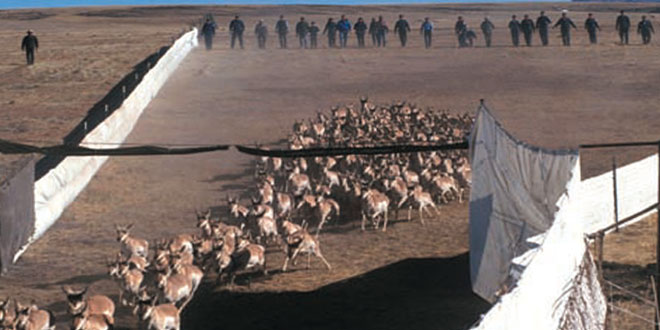New Mexico Wildlife (Summer 2005, Vol 49 Num 2)
Making Tracks: A Century of Wildlife Management, Part 9 of 9
Bringing back the game: ambitious, innovative actions restore and protect wildlife
By John Crenshaw
Former Public Affairs chief, New Mexico Wildlife editor, and game warden, retired in 1997.
New Mexico’s first territorial game warden was appointed in 1903. There was no school of wildlife management, no state fish hatchery system and few, if any, Rocky Mountain bighorn sheep and elk.
The Department of Game and Fish has grown out of that first appointment to an agency authorized to employ 286.5 individuals. Their mission is to provide the people of New Mexico with a flexible system of fish and wildlife management that perpetuates the state’s vast wealth of wildlife species.
During the last century of challenge, the agency has restored elk – too well in some minds; put Bighorn sheep back on the mountains; constructed and reconstructed six fish hatcheries with a seventh in the works. Along the trail the Department has assumed new responsibilities as the public’s desire to retain its wildlife heritage embraced species once believed less than desirable.
With this 9-part series of New Mexico Wildlife, we look at the tracks this outfit made during its first century. Those tracks lead to the highest peak, and to the hottest desert, anywhere wildlife might need a helping hand.
Above: The New Mexico Department of Game and Fish was the first state agency In the nation to use wing traps to capture large numbers of antelope. Photo: Don MacCarter.
Bringing back the game
When Warden Gable kicked the gate open to release those elk into the wild, he kicked off a century of big game management practices that grew far beyond the early game managers’ triad of law enforcement, predator control and game refuges. As years passed, the tiny territorial game and fish agency’s successors worked incessantly to restore and replenish big game mammals and birds. Along the way, they pioneered some techniques that made the agency an innovative leader in wildlife management, learning through trial and error, sharing and borrowing ideas and methods from other state agencies.
“Realizing the importance of stocking our forests with these superb animals and recognizing the natural conditions so manifest here, I purchased with monies derived from the game protection fund, 12 head of 3-year-old elk, in Routt County, Colorado.” – State Game Warden Thomas Gable, report of 1909-1911.
Among the tools the agency developed were wing traps to capture large numbers of antelope, drive nets for trapping deer and elk in substantive numbers, and use of tranquilizer darts fired from helicopters to capture individual animals. It introduced the use of net guns fired from helicopters, a method developed in Australia, and was a pioneering user of radio tracking telemetry and computer modeling.
Significantly, Gable funded his elk project by revenues from hunting licenses, first required in 1909 and a core funding source for the self-supported game department and its wildlife projects ever since. The license buyers themselves lent the social and political impetus to that project and the host of others that brought creatures such as elk and Rocky Mountain bighorn sheep, both completely eliminated from New Mexico, back into the state.
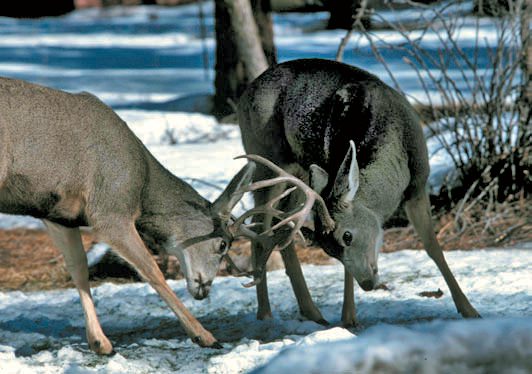
Although not extirpated from New Mexico, other native species such as antelope, desert bighorn sheep, turkey, quail, prairie chickens, ducks and geese, black bear, javelina, beaver, even cougar, also benefited from the funding and management mandates dating to the late 1800s. The wildlife agency and private landowners also set about bringing in species altogether new to New Mexico – exotic big game animals such as Barbary sheep, ibex and oryx in mid-century, but game birds from other parts of the country and world early on.
Upland game birds
Warden Gable, in his 1909-1911 report, writes about some of those early attempts to establish new game birds in the state. Game bird hunters clamored for pheasants, for instance, and he tried to accommodate them. Although blanching at prices of $40 a pair for Mongolian pheasants, $5 for English imports, Gable “by way of experiment” purchased 31 pheasants and gave them to a deputy game warden, Captain M. S. Murray of Roswell, to tend to. Murray reported back that all the birds were alive and in good health, and had produced 50 young, but required more range than he had available in his pens.
He suggesting turning them loose in “the mountain country, as feed is abundant and shelter good.”
New Mexico’s mountains may not have been the best choice. Rancher William French of Cimarron, around 1900, freed 50 pheasants into bottomlands along the Cimarron River and Ponil Creek. Ten years later, he wrote to Gable, “There are still quite a number around this neighborhood … Of course, they have a great many enemies, both human as well as wild animals, but they have done well enough to show that when they are protected for a time they will increase and do well in this country.”
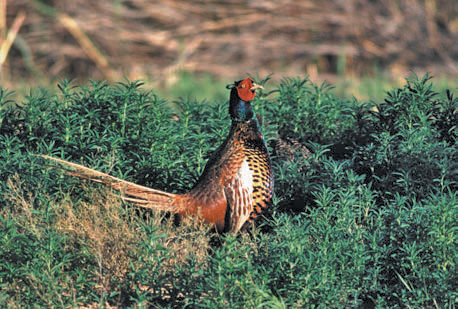
Photo: Don MacCarter.
Subsequent releases into river bottoms and croplands eventually built a small population of pheasants in the state, and the state had its first public hunt in 1936.
Perhaps most significant was how Gable acquired the birds. His swap of Scaled quail for bobwhites unveiled another key management tool for cash-strapped wildlife agencies – wildlife trades between the states quickly became and remain commonplace, often forming the core of restoration efforts.
Waterfowl and shore birds
“It must be admitted that many of our migratory birds are fast disappearing, some of them being almost extinct. Among these are the wild goose, canvass back duck and snipe, of which there are numerous varieties. There should be a national law enacted, protecting all migratory birds during their mating and nesting time, with a closed season, on some of them. This, I believe, will be eventually accomplished,” wrote Warden Gable in his report of 1909-1911.
It was, and with refinement and modification as conditions changed and science improved, the Migratory Bird Treaty Act of 1934 protects and helps propagate waterfowl and shorebirds to this date.
Earlier laws afforded some protections, but habitat, as with all wildlife, is the key.
The Pittman-Robertson Act and Migratory Waterfowl Hunting Stamp (duck stamp) pumped money into habitat salvage and restoration. New Mexico’s most visible contribution is its string of waterfowl management areas – wetlands and farms that shelter and feed wintering waterfowl – along the Rio Grande and Pecos River valleys.
Elk
The last Rocky Mountain elk in northern New Mexico was down by 1910, perhaps earlier. The southern herd, comprised of the Merriam’s subspecies, had gone extinct a decade earlier. The state felt the loss, although its early, ineffectual efforts to stop the market and subsistence hunting that brought it about came too late. The only way to bring them back was to bring them in from elsewhere and turn them loose.
It worked.
Gable’s 1911 operation was New Mexico’s first government-sponsored elk restocking project. It was one in a series of similar projects by public agencies and private landowners, such as the Bartlett Ranch (now Vermejo Park), which stocked 15 head that same year; the herd grew to some 500 in just 15 years.
The State Game Commission commissioned J. Stokley Ligon, a pioneering game biologist with the U.S. Biological Survey and conservationist Aldo Leopold’s highly respected peer, to research and report on the status of New Mexico’s game or potential game species. A highly valuable book, “Wild Life of New Mexico, Its Conservation and Management, 1926-1927,'” was the benchmark result. In it, Ligon estimated the state’s elk population at 712 in 1926.
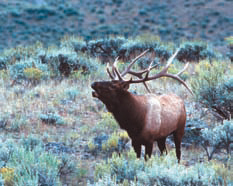
Gable had split his tiny herd into thirds – one bull and three cows – and released them in Red River Canyon (present-day Canadian River) northwest of Raton, Gallinas Canyon west of Las Vegas, and on the Urraca Ranch in Cimarron Canyon west of Cimarron.
The Gallinas stocking failed, but the others took, establishing what today is one of New Mexico’s most outstanding recreational and economical resources.
Former Game and Fish Department Director Bill Huey, then an assistant director, picked up the pace markedly in the 1960s.
“I was fascinated by the availability of elk and how it fit the demands of our hunters,” Huey said. “We had a good little elk population and had drawings for a few elk licenses. Then I found out I could go up to South Dakota, pay rent on a truck, and they’d bring them down to us. We planted elk in the Gila, in the Capitans. We backed trucks up to a snow bank and kicked elk out at Los Alamos Ski Area; now they’re estimating 4,000 to 7,000 head in the Valle Grande. And all we needed was just enough money to rent a truck,” he recalled.
The hunting public fully backed the restocking efforts, looking forward to a hunt, and the agency successfully encouraged U.S. Forest Service logging practices that favored the species, said Dan Sutcliffe, former chief of the Game Management Division.
“The Forest Service made changes in timber and grazing management in the ’60s and early ’70s, with us egging them on, that favored elk more than deer, and it worked. The department pushed them to do habitat manipulations, to do (logging) cuts to benefit elk. The changes really started kicking in in the late ’70s and ’80s, and the numbers really started increasing.”
As the elk population increased, proposals for liberalizing seasons met resistance.
But against some opposition, the State Game Commission opened the Pecos high country to the first elk season in 1934. Now, different configurations of weapons types, season dates, bag limits, units, subunits, public land and private land hunts produce an astonishing number of hunt choices.
With an elk population now estimated at 72,000 head, a reputation for trophy bulls and high hunter success rates, New Mexico’s citizenry continues to reap rewards while the state and private landowners work on ways to balance profits with proper wildlife management.
“Today, our vast amounts of public land, along with landowners who appreciate elk as a natural and financial resource has made New Mexico the best state in the country to hunt trophy elk,” said Steve Kohlmann, the Department’s chief elk biologist. “Where else in the country can someone draw a permit on public land to hunt record-book trophies like ours? Because of that, everyone profits – the wildlife, the hunters, the landowners and the communities.”
From license and equipment sales to guide and landowner fees, lodging, food and other expenses, elk hunting contributes more than $100 million a year to New Mexico’s economy, according to one recent study. Non-hunting activities involving elk, primarily wildlife viewing, injects another $1 million or so into mostly rural coffers each year.
Antelope
This is a uniquely American species, “the fleetest and among the most interesting inhabitants of the North American plains,” wrote Ligon in Wild Life of New Mexico.
“Formerly antelope were abundant on practically all of the open plains country of New Mexico, but because of exposure to their most fatal enemy, civilized man, they have been shamefully destroyed.”
He pinned the blame on homesteaders, “confronted with extreme poverty but with an excess of idleness,” for eliminating most of the state’s pronghorn population. A few remnant herds remained, however, mostly on large private ranches where the owners protected them. His population estimate was 2,957 head, “a sufficient number of antelope so distributed that re-establishment of the species is possible.”
Capturing the antelope and moving them to suitable grasslands around the state was the logical thing to do, but no one had ever done it on any sizeable scale and a decade passed before anyone did.
New Mexico was the first.
As Elliott Barker related it, the State Game Commission Chairman, Judge Colin Neblett, told him to trap and move pronghorns to restock depleted ranges. Barker told him it couldn’t be done, and Judge Neblett told him to find a way.
Barker cheerfully admitted delegating the task to Paul Russell, who adapted wild horse hunters’ techniques, and in 1937 the New Mexico Game and Fish Department became the first state agency to trap and restock antelope in substantive numbers. Although the whop-whop of helicopter blades has replaced the whoops of early horsemen, the basics remain. The game department’s trapping and moving of more than 1,000 head in one massive operation in the early 1990s stands as testimony to that.
Because it is a highly visible plains species, antelope are relatively easy to managerial counts and fawn crop surveys provide solid base numbers, and managers set hunting license numbers according to the data.
Mule deer
“Taking New Mexico as a whole, mule deer are by far the most important big game at the present time,” was Ligon’s assessment. The popularity and rapidly growing elk population notwithstanding, his statement is arguably still true. Although mule deer numbers in New Mexico and throughout the Rocky Mountain west have continued to decline for several decades, even now the state holds more mule deer than it did in Ligon’s day and quite possibly more than in pre-European times.
Working with U.S. Forest Service, Biological Survey staff, Game and Fish Department officers and others, Ligon estimated the mule deer population then at 41,000 head in 1926. Today, it is estimated at somewhere between 50,000 and 90,000.
Early European explorers in the West, including New Mexico, often remarked on the scarcity of deer, which they found in pockets but not in widespread abundance. Closed seasons, law enforcement, game refuges and natural process of plant habitat succession that followed fires and logging helped the population grow during the first half of the century.
Then a combination of factors created an astoundingly large jump in the West’s, and New Mexico’s, mule deer populations after the end of World War II, an irruption that still colors the public’s and managers’ perception of what the deer population should be but which, it becomes increasingly clear, was an anomaly unlikely to be repeated.
Former game department director Bill Huey was in the early wave of college-educated wildlife biology majors to join the agency, and came on just as the deer population growth was becoming fully apparent in the late 1940s and early ’50s.
“We had a super abundance of deer at that time; why, I don’t know and I don’t suppose anybody else did either. They did find a serious problem of over population in the herds, though, and the only way to address that was through either-sex hunting, to cut down the excess pressure on the forage supply,” he said.
Intensive predator control was also a factor in the population growth, he said, although not widely acknowledged at the time.
“We all resisted the effects of coyotes, but during that period there weren’t any coyotes to speak of,” he said, attributing that to the widespread use of Compound 1080 (sodium fluoroacetate) a highly effective and easy-to-use predicide introduced into the United States in 1945.
“I couldn’t say that that was the primary reason for the increase in the deer population, but it contributed to it. We were also in a rich period of high-quality forage production,” he said.
Tightening or loosening bag limits, seasons and hunter pressure can be effective when game populations are burgeoning but can be frustratingly inadequate when populations decline for reasons outside of an agency’s, or even humans’, control.
Dan Sutcliffe, a former Game Management Division chief with the agency, empathizes with today’s managers.
“The real power for managing any of those deer herds is habitat management, which we (game managers) have very little control over. Our end of it was pretty limited; we can deal with time frames, the numbers of hunters we let out there, harvest levels and those types of things. But if you really want to grow the deer, you’ve got to work with the habitat,” he said.
Bighorn sheep
The post-Civil War rush to New Mexico doomed the bighorn sheep throughout the West. Stokley Ligon attributed the extirpation to hunting, but diseases transferred from domestic sheep to wild bighorn sheep may have played an even larger role in the wild sheep’s decline. Presence of domestic sheep also stalled later reintroduction efforts.
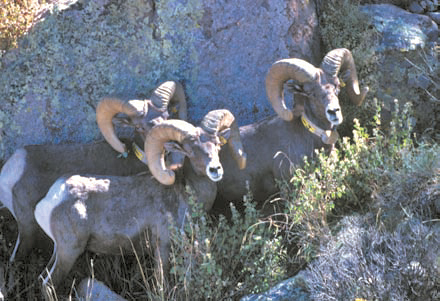
Elliott Barker wrote that the last Rocky Mountain bighorn in New Mexico was killed in 1902 near Lake Katherine, east of Santa Fe Baldy.
“My first restoration project (as State Game Warden) was to try to re-establish Rocky Mountain bighorns in the timberline country of what is now the Pecos Wilderness,” he wrote in Ramblings in the Field of Conservation.
After considerable searching, he finagled two rams and four ewes from Banff, Alberta National Park in Canada and released them in the Pecos Baldy /Truchas Peaks area. They lived for several years, “then mysteriously disappeared,” Barker wrote. The sheep likely were killed by diseases transmitted from domestic sheep grazing in the area.
Barker had seeded a small herd in the Sandia Mountains near Albuquerque by 1941, and a second transplant from Banff into the Pecos in the late 1960s also succeeded. The Pecos herd is thriving and has enough sheep for limited hunting and to furnish a supply for transplanting to other areas, such as the Wheeler Peak – Latir area, Manzano Mountains and the Gila National Forest. The Sandia herd eventually succumbed, probably to pressure from mountain lions, people, feral dogs and other hazards of being near the state’s largest city.
Today, the desert bighorn herd contained and protected in the 2.5-square-mile Red Rock area has provided brood stock to help restore the state-endangered desert bighorn herds in the Big Hatchets, Peloncillo and Alamo Hueco Mountains in New Mexico’s boot heel area, and in the Sierra Ladron near Socorro.
Predators
However controversial elk and deer management may be, predatory animals stir even greater emotions. As humans, we haven’t been able to reach consensus on them at all.
Early on, perhaps, there was more clarity of purpose: Kill them. The first wildlife-related laws in New Mexico were not about preserving bison or elk or deer, but provided for bounties on the heads of predatory animals that did or just might prey on livestock. Killing predators to protect prey species, such as deer, elk or bighorns, was an afterthought at first but later took on significant importance and commanded substantial resources.
An early sign of changing attitudes came in 1971, when the New Mexico Legislature, at the behest of then-State Representative and later State Game Commission Chairman Jamie Koch, gave the mountain lion status as a protected game animal. That removed its varmint status and gave the commission authority to limit take through closed seasons, bag limits and restrictions against traps and poisons.
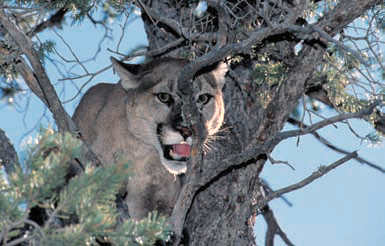
The Mexican wolf restoration project now underway in southeastern Arizona and southwestern New Mexico is an even more vivid sign of evolving perceptions about large predators. Although still strongly opposed by stockmen and some hunters, a much more urbanized citizenry as a whole supports the action. The current State Game Commission voted last year to support the effort, as well.
A few wildlife advocates suggest a similar project for grizzly bears. That would be even more controversial. Grizzly bears, whose aggressiveness and livestock depredations were not tolerated, were gone in the early 1930s; the last one was taken out of the Black Range.
Lobos and grizzlies were eliminated, and the federal government, state wildlife agency, ranchers, farmers and hunters kept the pressure on mountain lions, coyotes, bobcats and golden eagles. Predator bounties were common, and the state agency employed or contracted with trappers and hunters to pursue predators.
The agency’s 1941 annual report is typical: It lists 29 mountain lions, 464 bobcats, 1,745 coyotes, 439 skunks, 113 foxes, 168 eagles, 161 hawks, 52 owls, and 388 “miscellaneous” as taken by employees and contractors during the fiscal year.
“The outstanding feature of our predator control work was the payment of a $3.00 bounty on coyotes and a $2.00 bounty on bobcats taken in Catron County and a part of Sierra and Socorro Counties,” Warden Barker wrote.
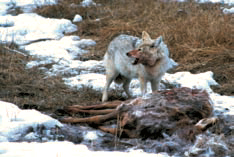
Mountain lions nonetheless survived in remote areas, and coyotes were never endangered by the trapping and shooting – there are in fact by far more of the opportunistic canines across a much wider range than in pre-European times.
Predator control was part of virtually all transplants and restocking efforts through most of the agency’s history. It fell out of favor temporarily in the 1980s, but has now been reinstated under limited circumstances. Mountain lion depredation on 31 desert sheep stocked in the Ladron Mountains in 1992-93 accounted for a dozen of 16 documented deaths among the sheep. The choice was to abandon the restoration project or remove lions, and the agency chose the latter. A high, almost predator-proof fence protects the desert sheep at Red Rock, and any mountain lion or coyote that works its way into the enclosure will be killed.
Predator control’s use as a tool, however, is limited, focused, monitored and reviewed; prevailing public and agency attitudes would not allow a reversion to the broadcast approach of the past.
Exotic big game
New Mexico’s varied experiences with imported “exotic” game species began in the 1950s, when Elliott Barker traded a dozen pronghorn antelope for a dozen Barbary sheep from southeastern New Mexico rancher Joe McKnight’s private game park and turned them out in the C.inadian River Canyon near Roy. Supplemented by subsequent plantings, the Barbary sheep did fairly well and are still hunted, but they also got into places where they are unwelcome. Their presence in the Guadalupe Mountains, for instance, precluded restocking of native desert bighorns in that area.
Although Barker met little resistance at the time, a subsequent and larger-scale project spearheaded by Dr. Frank Hibben, chairman of the State Game Commission, created quite a firestorm in the 1960s and early 1970s.
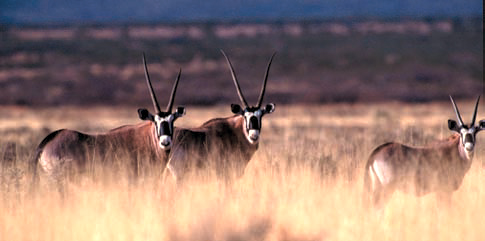
Some of the resistance came from agency biologists, but Hibben over-ruled them, said Bill Huey, assistant director at the time.
“If we (the staff) had had the prerogative, we never would have had them, but Frank’s the one that had that prerogative. He ordered them and bought them, and when they got here it became our responsibility to identify what effect they would have on other native wildlife and what effect they would have on domestic livestock on privately owned land,” Huey said.
The department evaluated seven species oryx, Persian ibex, Siberian ibex, greater kudu, Armenian red sheep, markhor, and gazelle – at the Red Rock Wildlife area.
“We discarded the kudu. They couldn’t accommodate the cold. We discarded the Armenian red sheep because of the potentially adverse effect it would have on other sheep,” Huey said. Markhor and gazelle were also unsuitable.
Ultimately, the department released oryx on White Sands Missile Range, Persian (Iranian) ibex in the Florida Mountains and Siberian ibex in the Canadian River Canyon near Roy. The Siberians apparently died out; the other two species thrived.
Both species, Huey believes, still provide challenging sport and can be contained and controlled through sport hunting.
 New Mexico Wildlife magazine Conserving New Mexico's Wildlife for Future Generations
New Mexico Wildlife magazine Conserving New Mexico's Wildlife for Future Generations
